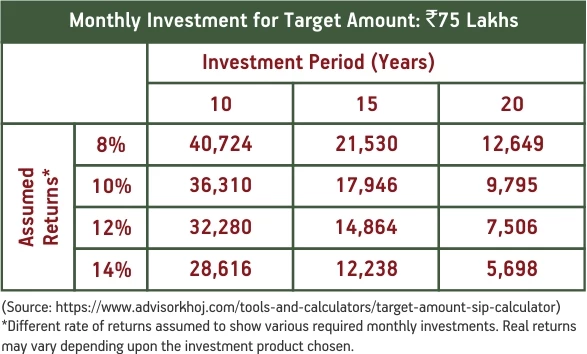-
Our Products
Our FundsFocus Funds
-
Self Care
Self-ServiceFind InformationWays To TransactPartner Solutions
-
Downloads
- Learnings
- About Us
-
More
-
Shareholders
-
Shareholders
-
Updates
-
-
SIP Calculators
- Back
-
Shareholders
5 Must Have Investments For Your Child's Future Plan Portfolio
Aug 01, 2019
5 mins
5 Rating
Saving for your child’s education is directly proportional to your regular contribution to your entire financial plan
Biggest Cash Outflow is saving for higher/professional degree education
2-year Post Graduate Programme in Management
2018 - MBA course – Rs 22 lakhs approx
2027 – MBA course – Rs 40 lakhs approx
2036 – MBA course – Rs 75 lakhs approx
(Assuming cost of education rising by 7% every year)
Source: https://www.iima.ac.in/web/pgp/apply/domestic/expenses
Lifestyle & Inflation
Standard of living & Inflation = Choice of where to send child for higher education, Child’s marriage in future etc
How to break through?
1. Be the Early-Bird
Don’t underestimate the Power of Compounding - Illustration
Current Child Age – 1 year Target corpus –Rs 75 lakhs Monthly Investment Target
2. Aim to invest in Right Options
a. Equity funds can be considered for long term
b. For short term needs such as school fees, uniform expenses, medical etc Debt or money market instruments can be considered
3. You can consider Children’s Funds
These invest in a combination of Debt and Equity instruments.
Comes with a lock in period to encourage long term investing for child
Provides an option to start Systematic Investment Plan (SIP)
4. You can invest in Gold for long term
Gold can be considered as an investment option
Invest through ETFs, Gold Fund or E-Gold
Gold can hedge during volatile times
You can allocate 10 – 15% of your overall portfolio towards gold
5. Investments and Insurance
Prudent to keep them separate
Insurance may cater to expenses after one’s demise
Aim to take appropriate cover as per your profile
Separate investment in Equities/Debt can help build corpus and wealth over long term
6. Skills and Values
Invest in child’s skill set – Art, Sports, Technology etc
Teach values – Honesty, Determination, Consideration etc
Mutual Fund investments are subject to market risks, read all scheme related documents carefully.
Similar Articles





 1800-270-7000
1800-270-7000










